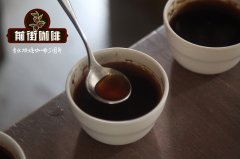Costa Rica Tarajupena Pena Farm Yellow Honey Processed Coffee Flavor Taste Introduction

Professional coffee knowledge exchange more coffee bean information please follow the coffee workshop (Wechat official account cafe_style)
Coffee has been rooted in Costa Rica for more than 200 years. Although its land area is only the third from the bottom of Central America, it is an indispensable and important role. At present, Costa Rica has a total population of about 4.5 million. But there are as many as 400 million coffee trees.
Coffee exports account for 25% of the country's total exports, and according to local statistics, about 1 jump 3 of the population is involved in the coffee-related industry chain. It is not too much to say that coffee has changed the country's standard of living.
Costa Rica has a unique natural environment, fertile volcanic ash, mild and suitable temperature, stable and abundant rainfall, sufficient sunshine during the day, and a significant temperature difference between day and night.
It is one of the reasons why coffee has become one of the main agricultural products in Colombia.
They also produce different grades of coffee raw beans, from commercial Arabica beans to coffee beans from the Outstanding Cup Coffee Competition (COE), as well as the palace-level geisha coffee variety (Geisha).
In addition, there are numerous post-processing methods of yellow, red and black, which are dazzling and numerous.
According to the traditional classification, Costa Rica is divided into seven producing areas, from northwest to southeast, along with the inland central plateau, Western Valley (West Valley), Central Valley (Central Valley), Tarasu (Tarrazu), Sanshui River (Tres Rios), Eurosci Orosi, Brunca, Turrialba, several of which may be familiar to everyone in Taiwan's coffee market, but with the evolution of boutique coffee The norms of large producing areas can no longer satisfy the curiosity of lovers chasing high-quality coffee, resulting in more and more micro-areas and small estates being excavated.
Dota belongs to a small independent producing area within Tarrazu, which is not close to other coffee growing areas of Tarrazu, so it has different climatic conditions, topography and unique soil.
As a result, the flavor of beans in Dota producing area is different from that in Tarrazu producing area.
Good Dota beans are mostly small, but highly concentrated and contain excellent Body, and its unique dark chocolate flavor is lacking in other Costa Rican coffees.
In Costa Rica, honey treatment and sun-dried beans are derived from small farms with certain difficulties. Pena Pena Farm is located in the Tarazu Valley, about 70 kilometers southwest of San Jose, the capital of Costa Rica. This is a paradise area with rich green vegetation and clear rivers. Coffee beans are harvested once a year, and the harvest begins in December and lasts until March of the following year, with an average annual rainfall of 2900 mm and an average temperature of 18 degrees Celsius.
Property Characteristics: farm characteristics Farm Farm name: La Pena Farmer Farm owner: Santa Cruz Region producing area: Tarrazu Valley Tarazu
Country country: Costa Rica Altitude altitude: 1650-1700m Coffee Characteristics: coffee characteristics
Variety varieties: Caturra, Bourbon, Typica Kaddura Bourbon Tibica Processing System treatment: Honey honey treatment
Harvest time: End of November-March November to March next year Top Jury Descriptions judges' comments: the baking degree (Cinnamon) measured for the cup in 60 seconds at the beginning of the first explosion
Aroma aroma / flavor flavor: clove, peanut, cinnamon, black tea, basil, peach, maple syrup, caramel, acid: Apple, blueberry, yellow lime, ester smooth taste in acid
Complex complexity and other other: spice dry aroma is great, simple clean little change, velvety taste, peach and apple sweet
Overall style attributes: very smooth, sweet peaches, flavor of the new century
Important Notice :
前街咖啡 FrontStreet Coffee has moved to new addredd:
FrontStreet Coffee Address: 315,Donghua East Road,GuangZhou
Tel:020 38364473
- Prev

Brief introduction of Costa Rican boutique coffee manor-Don Mario manor honey treatment
Professional coffee knowledge exchange more coffee bean information Please pay attention to the coffee workshop (Wechat official account cafe_style) the Costa Rican coffee growing area has rich volcanic ash, mild and suitable temperature, and stable and abundant rainfall, which is one of the factors that make coffee a major agricultural product in Costa Rica. Its coffee beans are all Arabica species. Pure flavor, pleasant aroma, no
- Next

Where are the coffee growing areas in Brazil? the main coffee growing areas in South Minas.
Professional coffee knowledge exchange more coffee bean information please follow the coffee workshop (Wechat official account cafe_style) Brazil's main producing areas are Minas Gerais MinasGerais, S ã o Paulo Sao Paulo, Bahia Bahia and Esp í rito Santo Espirito Santo these four places account for 90% of the country's exports, our common Santos Santos and Mochiana Mogiana are from
Related
- Does Rose Summer choose Blue, Green or Red? Detailed explanation of Rose Summer Coffee plots and Classification in Panamanian Jade Manor
- What is the difference between the origin, producing area, processing plant, cooperative and manor of coffee beans?
- How fine does the espresso powder fit? how to grind the espresso?
- Sca coffee roasting degree color card coffee roasting degree 8 roasting color values what do you mean?
- The practice of lattes: how to make lattes at home
- Introduction to Indonesian Fine Coffee beans-- Java Coffee producing area of Indonesian Arabica Coffee
- How much will the flavor of light and medium roasted rose summer be expressed? What baking level is rose summer suitable for?
- Introduction to the characteristics of washing, sun-drying or wet-planing coffee commonly used in Mantenin, Indonesia
- Price characteristics of Arabica Coffee Bean Starbucks introduction to Manning Coffee Bean Taste producing area Variety Manor
- What is the authentic Yega flavor? What are the flavor characteristics of the really excellent Yejasuffi coffee beans?

